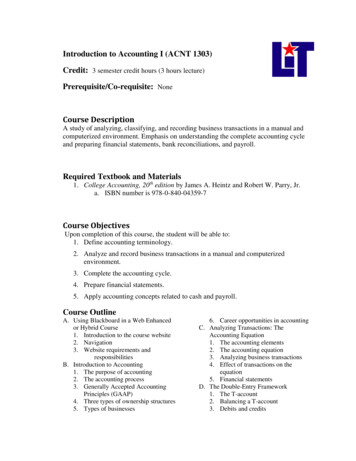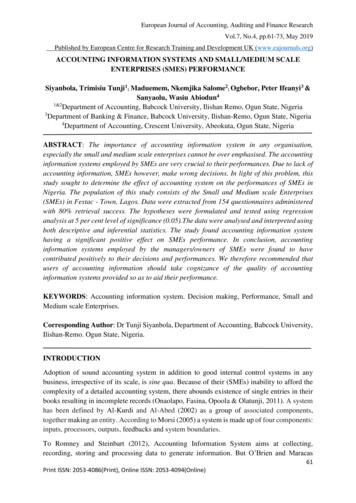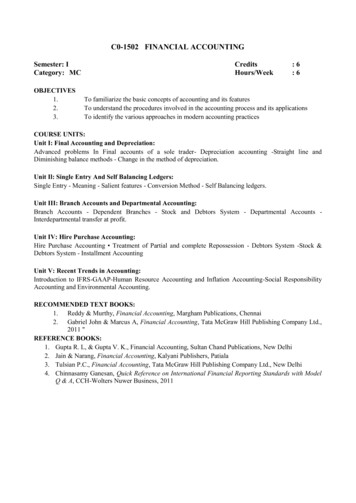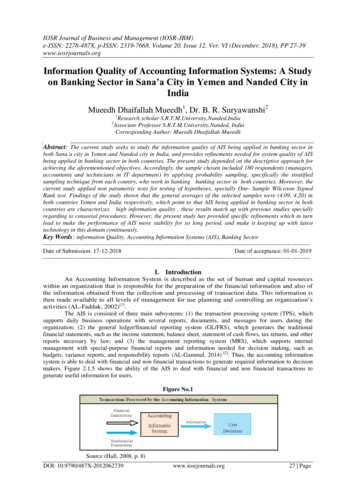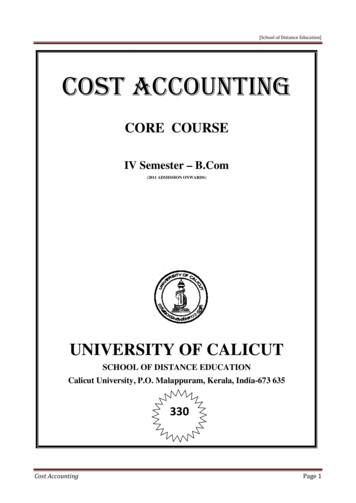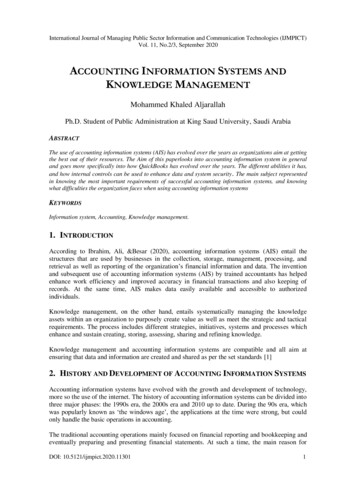
Transcription
International Journal of Managing Public Sector Information and Communication Technologies (IJMPICT)Vol. 11, No.2/3, September 2020ACCOUNTING INFORMATION SYSTEMS ANDKNOWLEDGE MANAGEMENTMohammed Khaled AljarallahPh.D. Student of Public Administration at King Saud University, Saudi ArabiaABSTRACTThe use of accounting information systems (AIS) has evolved over the years as organizations aim at gettingthe best out of their resources. The Aim of this paperlooks into accounting information system in generaland goes more specifically into how QuickBooks has evolved over the years. The different abilities it has,and how internal controls can be used to enhance data and system security . The main subject representedin knowing the most important requirements of successful accounting information systems, and knowingwhat difficulties the organization faces when using accounting information systemsKEYWORDSInformation system, Accounting, Knowledge management.1. INTRODUCTIONAccording to Ibrahim, Ali, &Besar (2020), accounting information systems (AIS) entail thestructures that are used by businesses in the collection, storage, management, processing, andretrieval as well as reporting of the organization’s financial information and data. The inventionand subsequent use of accounting information systems (AIS) by trained accountants has helpedenhance work efficiency and improved accuracy in financial transactions and also keeping ofrecords. At the same time, AIS makes data easily available and accessible to authorizedindividuals.Knowledge management, on the other hand, entails systematically managing the knowledgeassets within an organization to purposely create value as well as meet the strategic and tacticalrequirements. The process includes different strategies, initiatives, systems and processes whichenhance and sustain creating, storing, assessing, sharing and refining knowledge.Knowledge management and accounting information systems are compatible and all aim atensuring that data and information are created and shared as per the set standards [1]2. HISTORY AND DEVELOPMENT OF ACCOUNTING INFORMATION SYSTEMSAccounting information systems have evolved with the growth and development of technology,more so the use of the internet. The history of accounting information systems can be divided intothree major phases: the 1990s era, the 2000s era and 2010 up to date. During the 90s era, whichwas popularly known as ‘the windows age’, the applications at the time were strong, but couldonly handle the basic operations in accounting.The traditional accounting operations mainly focused on financial reporting and bookkeeping andeventually preparing and presenting financial statements. At such a time, the main reason forDOI: 10.5121/ijmpict.2020.113011
International Journal of Managing Public Sector Information and Communication Technologies (IJMPICT)Vol. 11, No.2/3, September 2020accounting information was to give the users of accounting information, the data required tounderstand the financial position and direction of the organization. This objective was attainedthrough the use of small systems created purposely to support reporting of financial information[2].After accounting operations were automated, technology improved, changing further into theautomation of document management and collection, through the creation of methods like einvoicing, e-payments as well as e-archiving. Technology in this regard responded well to thedemands in the market, with accounting software that could be customized to meet the demandsand needs of every organization, matching their profile and operational practices. Transparencyin accounting improved as transactions could be tracked to the source, hence reduced cases offund embezzlement through accounting systems.3. USE OF INTERNAL CONTROLS TO CONTAIN OCCUPATIONAL FRAUDAccording to Steckel (2011), occupational fraud entails using an individual’s occupation toenrich oneself through deliberately misapplying and misusing the resources in the organization.In many cases, it is the employees who violate the trust that they have been bestowed upon bytheir employers and use their position to gain wrongly. However, as per Steckel organizations cancreate internal controls to ensure that the majority if not all loopholes have been sealed. Internalcontrol is a process impacted by a firm’s management, directors and other stakeholders, meant tooffer possible assurance on the attainment of organization objectivesMethods for attaining strong internal controls in different organizations are:3.1. Business Laws and Regulations on Information Systems UseAny organization operating in a country with laws must abide by the set rules and regulationsabout business operations. Steckel (2011) notes that besides making sure of reliable financialrecords and safeguarded assets, any organization using AIS should ensure that their systemsadhere to the regulatory requirements. These regulations are mandated by the (PCI) PaymentCard Industry, as provided by the PCI council (2010). At the same time, here has been theenactment of data breach notification laws over the past few years to ensure that informationsystems are used appropriately without breaching any kind of individual or organizational law.The laws state that organizations are required to ensure that they inform that customer if by anychance, a breach to the organization or customer data has been experienced.3.2. Finding Software Features Related to Internal ControlThere is some literature on the software security built-in features exist, discussing the importanceof using the features and the way they should be used to enhance safety for the accountingsystems. Intuit, the developer of QuickBooks published a manual on how small businesses canuse internal controls to decrease the potential risks of fraud. Although the manual discusses howinternal controls are used in business, it mainly discusses how they should be implemented. Thisshows that implementation is the most important aspect of internal controls as that determines thelevel of success.Moreover, Steckel (2011) indicates that usernames and passwords are part of the internalcontrols. However, even though there are built-in features of internal control within QuickBooks,there is no empirical research done to determine whether the features are used well in practice.2
International Journal of Managing Public Sector Information and Communication Technologies (IJMPICT)Vol. 11, No.2/3, September 2020However, existing literature offers a unique opportunity and experience in research to contributeto the accounting field.3.3. Security Level Maintained by Small Business on Information Through InternalControlsTo determine this, Steckel conducted an online survey, listing 10 most important and basicfeatures to be tested. The research featured a total of 200 organizations, whereby only 36responded (18% response rate). However, 21 of the 36 organizations that responded indicated tohave used one version of QuickBooks accounting software. The majority of the organizationsindicated that they use a desktop version, with only one indicating to be using an online version.This meant that the researcher could not come to a complete conclusion based on a response fromonly one online user. The researcher also examined whether the users utilized usernames andpasswords for the desktop version, and a total of 30% indicated that they do not have usernamesor desktop, but 70% indicated that they have set usernames and passwords as extra securitymeasures. This shows that not all the organizations and users of QuickBooks make use of theavailable internal control measures and features within their systems.The Steckel’s study adds new knowledge to the current increasing trend of organizations goingonline to operate remotely through the use of procured online systems such as QuickBooks. Atthe same time, there is new knowledge and literature added to accounting systems security. Theknowledge is important because there are increasing cases of attacks on organization systemsfrom hackers, who steal information, alter information or even channel funds from theorganization accounts to their accounts without being noticed.4. IMPORTANCE OF INFORMATION SYSTEMSOCIOTECHNICAL ASPECTANDTECHNOLOGYFROMIt is important to project information systems as well as technology in a sociotechnical approach.A sociotechnical system is the one that has a social organization and material technology as well.This aspect of the system has come up with many changes that have a positive impact.Employees work is based on unity and not in segmented tasks. This effort of unity inaccomplishing goals has led to a conducive working environment [3]. Employees are now doinga perfect work while interacting with fellow colleagues. While the effect of standardization andformality has reduced, workers are now expected to portray deep knowledge and understandingof their work. Through this, there is improvement in opportunities for making skills better.There is not only a rise in the level of satisfaction in employees, but also an increase in the levelof production. These levels as mentioned are considered as famous products in these aspects ofsocial-technicality. They are also referred to as autonomous groups. These groups have not yetbeen applied and accepted all over the world, but are proven to have some efficiency. Anotherimportance of this sociotechnical aspect in information systems and technology is that manymanagers who have a high position in management can be controlled partially within the groups.This implies that less amount of money is required for managers who are highly educated andwith higher skills which are well paid.Not much money will be used when dealing with these scenarios. The most important worth ofthis system is that, it touches those who gain the profit made and those that create that profit. Thesystem has been made to meet the needs of employees, that is, social needs and psychologicalneeds and that has risen the profit of the work done and put it together with technology. Thisincrease in a firm’s business cannot be successful without this information system in meeting3
International Journal of Managing Public Sector Information and Communication Technologies (IJMPICT)Vol. 11, No.2/3, September 2020their needs. It is important to view this technology from a socio-technological aspect becausetechnology is like a tool. This aspect has inspired many researchers who created an influence intheir associations were said to be influential researchers in initiating sociotechnical research ininformation systems. They were concerned with information systems, although they had a limit inengineering approaches.5. TYPES OF INFORMATION SYSTEM VALUABLE TO AN ORGANIZATIONInformation systems can be viewed as formal organizational systems aimed to collect, processstore and distribute information. Computer information systems are usually composed ofcomputers, infrastructure and people. Information systems can be broadly categorized into fourmain categories. These are Transaction processing systems (TPS) which are used in the datacollection and storage of incoming and outgoing transactions in an organization; decision-supportsystems (DSS) which are used to give support during the determination, judgement and action tobe taken in an organization. [4] They analyze the a lot of data and produce important informationthat is useful to the organization during the decision-making process to provide solutions to theproblems; Management information system (MIS) which is a database where financialinformation which is organized and programmed to produce reports regularly on the operation ofthe organization on each level of management in the organization and executive support systemswhich are also referred to as the executive information systems are management support systemssupport the senior executive information and facilitate decision making .[5] They enable thesenior executive to access the external and internal information that is related to the attainment ofthe organization goals easily.Transaction processing system is used in the operational level systems, while managementsystems use MIS and DSSs and final the executive systems are involving strategic level systems.Transactions systems are mainly used in the collection of data, storage of both incoming andoutgoing transactions within the business [6]. The system enables data transaction in the databasesystem that monitors how the transaction programs are running. They are very essential throughthe performance of the business, data integrity, growth and availability. The systems areintegrated in the selling of items on online market since they allow time delay between when theitem was sold and the actual time when the item was sold. TPS is the most important systemsand also the most valuable in any organization [4]. This is due to the fact that this level isinvolved with more work on a daily basis than the other levels in the organization. The systemsrecord the daily routine transactions that take place in the operation of the organization daily.Transaction processing systems also collect data and combine it into various forms that enablethe organization to become more organized and orderly leading to its success. The systems arethe best when they provide the users with the required high quality and useful information whenit required for the running of the organization.6. IMPACT OF NEW INFORMATION SYSTEMSInformation systems play a very important role in the success of an organization or organization.In the current era its where digital economics, globalization and digital organization is takingplace, it’s no longer about if an organization should have an information system but it’s aboutwhether the organization has an information system it’s about if the information system in theorganization is effective. [7] Therefore, the success of the information system is a hugedeterminant/ has huge influence on the success of the organization. Implementation of a newsystem of an organization will affect the organizations culture and politics in different ways.4
International Journal of Managing Public Sector Information and Communication Technologies (IJMPICT)Vol. 11, No.2/3, September 2020The culture of organizations is mostly unassailable, bedrock assumption by its members thatdefine the goals and their products. The culture is the assumption of which products theorganization should produce and how they should produce, when and where they should beproduced. The actual business values are intertwined with the organization Culture of the firm[8]. New information system tries to implement and accommodate the culture, however there aresome changes which are made for successful implementation of the system. Information systemsaffect the culture based on the information quality, service quality, system user satisfaction andusefulness. The quality of the information that the new system provides has a huge impact on theculture of the organization. The information provided is used to make decisions which determinethe success of the organization [9]. High quality information provided to the superior will enablethem to make the appropriate decisions which will enable the organization to attain its goals. Inmost organizations, the superior is assumed to know it all. If the system provides them withinformation that leads them to making poor judgment calls will affect the culture negatively asthe inferior will start viewing them from a different perspective. Information system also has animpact on the organizational politics. Organization politics refers to the different positions thatpeople in an organization occupy based on concerns, perspectives and specialties.Based on those aspects they develop a natural viewpoint on matters regarding rewards,punishments and resources allocation. The difference concerns the managers and the employees.New information system in organizations will have several impacts on its functionality. Thecultural and political impacts are some of the most common witnessed impacts of newinformation system. Before development and implementation of a new system is done, itsrecommend that the factors are considered to determine how the system will have more positivecultural and political influence on the organization.7. THEORIES ON THE IMPACT OF ORGANIZATION SYSTEMThe difference between the economic theories and behavioral theories in relation to informationand technology can be analyzed and discussed based on their view and approach to informationtechnology[10].From the economic theory information systems can be viewed as a factor of production that canbe easily substituted with capital and labor. Information systems enable automation of productionprocesses; less labor and capital in order to produce a specified output. However, in behavioraltheory, information systems can be defined as a group of rights; privileges; obligations andresponsibilities which end up balancing within a given period of time through conflict andconflict resolution. The theory focus on how the information system influences the inner workingenvironment of the organization.The transaction cost theory which is based on the notion that the firm instead of making productsfor itself, incurs transaction costs when acquiring goods in the marketplace. Traditionally,organizations find ways to lower their transaction costs through getting bigger, hiring moreemployees, small-organization takeovers; horizontal and vertical integration thereforeinformation systems help the firms to minimize the transaction costs. They help the organizationin reducing in size with the same output production [11]. On the other hand the behavioralresearchers consider the information system influence on the decision making thus reducing theinformation acquisition cost and distribution cost. Information systems can eliminate the middlelevel managers and their support clerical by sending the information directly from the seniormanager to the lower-level operation units directly. This also enables the organization to act as avirtual firm since the geographical limitation is eliminated.5
International Journal of Managing Public Sector Information and Communication Technologies (IJMPICT)Vol. 11, No.2/3, September 2020Although the economic theory view information systems as a factor of production while thebehavioral theories view the information systems in regarding to their influence on the behaviorof people in carrying out their operations, both of them indicate that information system has apositive impact on the organization. There for firms are encouraged to adopt information systemson their production process and decision making.8. SUCCESS FACTORS OF AIS SOLUTIONS8.1. Service QualityFor accounting information systems succeed in organizations, the services that they deliver andthose that they offer should of high quality. The systems are normally put in place to enhancebetter performance through automated service delivery. Thus, the quality of service that theydeliver to the organization is a great determinant of how successful the accounting informationsystem will be in the organization. At the same time, AISs are normally connected to othersystems within the organization to enhance better resource utilization and better service delivery.As such, the quality of service and support provided from the other systems will determine howsuccessful the accounting information systems will be in the organization [12].8.2. Information QualityInformation is an important aspect of the success of any system’s operations. As such, theinformation provided about certain data determines how the data will be applied and interpretedby AIS, hence success or failure. Accounting information systems are always expected to workusing high-quality information. As such, with high-quality information provided, accountinginformation systems are likely to run to the expected standards and produce high-quality resultsin the end. At the same time, poor quality information will translate to poor system operationsand failure, hence inability to achieve the set targets and standards of performance [13].8.3. Data QualityData is the most important component of any database that involves storage and analysis of data,hence determining the importance of such a database [14] Thus, it is always important to ensurethat the quality of data stored in the database and the quality of data used in processing is alwayshigh to enhance better system operations. Accounting information systems depend on the datapresented to do analysis and present reports that are used for decision-making. If in any casewrong data is presented and used in the analysis, then all the subsequent results and decisionsmade out of the data will be wrong. This will drive the organization in a wrong direction, hencecreate an image of a failed accounting system, which could have been avoided if the right datawas used in the analysis and making of decisions [13].8.4. System QualityThe quality of the accounting information system is also an important factor to consider whendetermining the success of the AIS. There are many vendors of AIS software in the markets andit is up to the organization to work towards ensuring that they select the best in terms of quality.Thus, proper vetting of vendors should be done to ensure that the best quality is selected in thisregard. When looking into the system quality, this is done in terms of system security, the abilityto withstand challenging times and downtimes, and system availability. System security is animportant aspect to consider because the data have been always important for organizations andensuring that the systems are protected against any form of harm brought to them. System6
International Journal of Managing Public Sector Information and Communication Technologies (IJMPICT)Vol. 11, No.2/3, September 2020downtimes can be stressing to users in systems, hence having systems that can withstand anypossible downtimes and that can also handle large amounts of data without crumbling is ameasure of a good quality system [12].9. CONCLUSIONAccounting information systems have become a critical part of organizational operationsacross different industries. It has become essential that the majority of the accounting tasks doneby people in the past be handled by automated systems. These systems have a wide range of capabilities,including coordinatingwithalldepartments and using the data available from the departments. AISs have also ensured thatthere is better accountability as no individual decisions are made without the systemkeeping the record. This has reduced the possible cases and instances of theft withinorganizations and enhanced better accountability [15]. With accounting information systems that well designed to meet organizational objectives,all stakeholders within the organization with access to data can access the systemand use the same information at the same time, without having to go througha lengthy process in the end. Organizations are faced with the dilemma of either purchasing one or developing anaccounting information system that suits their business needs.oOne of the main factors is the cost of either production or getting the system off-the-self.Many at times, picking a system off-the-self is cheaper because they are developed inlarge numbers and tend to be uniform in operations depending on the industry ororganization that one operates. However, developing a customized system is a bitchallenging, hence costly to develop [16]. If an organization has an existing system thatis already operating, then it might consider developing a system that conforms to theirneeds and requirements.oThe time available will be crucial in determining the level of quality required in the newsystem to be developed, since having enough time will lead to a better system beingdeveloped, and having less time might make the system developers rush and not manageto attain the expected levels of the outcome.oThe main determinant should be the level of security that the system can assure theorganization in terms of keeping the customer data and the data of other stakeholderssafe. With technological developments and the invention of cloud computing has created a newdimension. Organizations like QuickBooks have taken advantage of the new developmentsin technology and captured a large part of the market share. An accounting information system to be successful.oThere mustbesufficientITinfrastructure. Inthis regard,theinfrastructure is mostly made up of computer hardware used in operating the accountingsystem; there must also be an operating system that will be used in controlling theoperating system and other related software.7
International Journal of Managing Public Sector Information and Communication Technologies (IJMPICT)Vol. 11, No.2/3, September 2020oAdditionally, to cost, some of the factors that must be considered when implementing anaccounting information system include scalability and the capacity for storage.oCompatibility is an issue that should always be considered when choosing hardware forAIS because systems are meant to run on hardware that can sustain them. One of themeans that businesses can meet the requirements of software and hardware compatibilityis through the purchase of a turnkey system which entails both the software and hardwarerequired by the business.oA good accounting information system should have a plan for use, maintenance, service,upgrading and replacing of components within the hardware system. This is to ensurethat organization data is safeguarded and any sensitive data is discarded to avoid anypossibility of leaking sensitive data to outside parties [17].oAn accounting information system must have internal controls to help them protectagainst unauthorized access in computers and also limit access to those who areauthorized to ensure that data is not compromised. Internal controls must also help toprevent any unauthorized access of files by people who have only been given privilegesto just access some parts of the 1][12][13][14][15]Ibrahim, F., Ali, D. N. H., & Besar, N. S. A, "Accounting Information Systems (AIS) in SMEs:Towards an integrated Framework," international Journal of Asian Business and InformationManagement (IJABIM),, pp. 51-61, 2010.Hingorani, K., & McNeal, B. , "Using Quickbooks Online Plus for Enhancing Learning Of ERPConcepts: A Case Study," issue in information system, pp. 132-139, 2018.McLeod, L., & Doolin, B. , "Information systems development as situated socio-technical change: aprocess approach," EUPOREAN JOURNAL OF INFORMATION SYSTEM, pp. 176-191, 2012.A. B. Qehaja, "ResearchGate," June 2013. [Online]. Available: https://www.researchgate.net/.T. Lucey, Management of information systems 9TH Edition, London: Thomson Learning, 2005.D. K. a. R. Hatch, Business Information systems 5th Edition, New York: Mc Grow Hill, ine].Available:https://paginas.fe.up.pt/ acbrito/laudon/ch3/chpt3-1main.htm.I. M. Romi, " Organization Culture Impact on Information Systems Success," April 2011. blication/233857776 Organizational Culture Impact on Information Systems Success.Ismail M. Romi,Ibrahim A. AwadManal Elkordy, "A Model of Organizational Politics Impact 1007/978-90-481-3660-5 19.Kenneth C. Laoudon and Jane P. Laudon, Management Information system, New Jersey: PrinticeHall, 2007.L. M. Lovata, "JSTOR," JOURNAL ARTICLE Behavioral Theories Relating to the Design ofInformation Systems, pp. 145- 147, 2000.Davis, J. T., Ramamoorti, S., & Krull Jr, G. W. , "Understanding, Evaluating, and MonitoringInternal Control Systems: A Case and Spreadsheet Based Pedagogical Approach," AIS educatorjournal, pp. 59-61, 2017.Ganyam, A. I., & Ivungu, J. A, "Effect of accounting information system on financial performance offirms: A review of literature," journal of business and managmenet, pp. 39-49, 2019.Hla, D., & Teru, S. P, "Efficiency of Accounting Information System and Performance Measures,"international journal of multidisciplinary and current research, pp. 976-984, 2015.S. N. Soudani, "The usefulness of an accounting information system for effective organizationalperformance," international journal of economic and finance, pp. 136-145, 2012.8
International Journal of Managing Public Sector Information and Communication Technologies (IJMPICT)Vol. 11, No.2/3, September 2020[16] N. Mndzebele, "The usage of accounting information systems for effective internal controls in thehotels," international jouranl of advanced comupter technology, pp. 1-3, 2013.[17] Z. M. Sori, "Accounting information systems (AIS) and knowledge management: a case study,"American Journal of scientific research, pp. 36-44, 2009.9
Transaction processing system is used in the operational level systems, while management systems use MIS and DSSs and final the executive systems are involving strategic level systems. Transactions systems are mainly used in the collection of data, storage of both incoming and outgoing transactions within the business [6].



